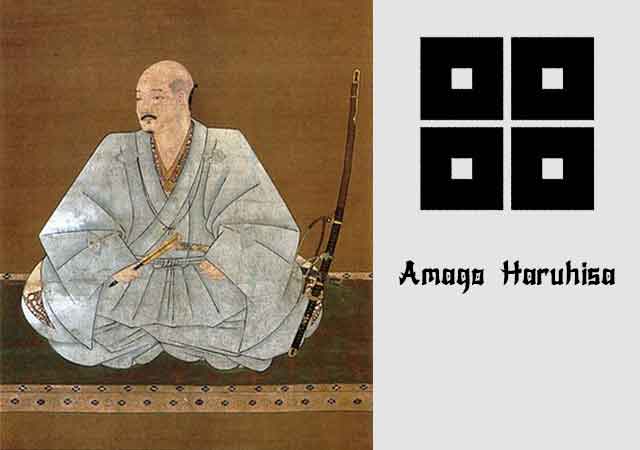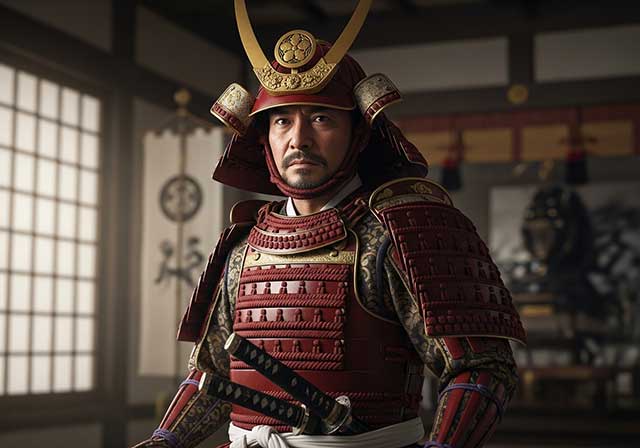
Amago Haruhisa (March 8, 1514 – January 9, 1561) was a powerful daimyō and warlord in the Chūgoku region of western Japan. Born as the second son of Amago Masahisa, he initially bore the name Akihisa, but in 1541, upon an offer from Ashikaga Yoshiharu, he adopted the name Haruhisa by incorporating a kanji character from Yoshiharu's own name.
Upon the untimely death of his father, Amago Masahisa, in battle, Haruhisa assumed leadership of the Amago clan in 1537, succeeding his grandfather. Eager to expand his territory, he launched a series of invasions, extending his influence as far as Harima. During his youth, he was known by the name Saburōshirō.
The Siege of Koriyama in 1540, pitting Haruhisa against Mōri Motonari, concluded in a humiliating defeat. This led to the defection of many of his retainers, who doubted Haruhisa's prospects for success. The subsequent year saw the passing of his grandfather, Amago Tsunehisa, and Ōuchi Yoshitaka initiated a counteroffensive to crush the Amago clan.
In the 1542–43 Siege of Toda Castle, Haruhisa successfully defended the castle. This victory not only bolstered his standing but also inspired the return of some of his earlier defectors. With sufficient forces gathered, he managed to repel the invasion and gradually solidified control over domains like Izumo, Hōki, Mimasaka, and Oki.
Following the death of Ōuchi Yoshitaka in 1551 due to the rebellion led by Sue Harukata, Haruhisa was offered lordship over eight domains by the Muromachi shogunate in 1552, four of which he already held in his firm grasp.
In his later years, Haruhisa made a sudden decision to eliminate his uncle Amago Kunihisa, along with the retainers under his command, collectively known as Shingūtō. This action, which initially led to a scarcity of experienced leaders, was likely a move by Haruhisa himself to consolidate his rule over the Amago clan, rather than a plot by Mori Motonari as depicted in certain fictional works.
After Sue Harutaka's defeat and death in the Battle of Miyajima, Haruhisa sought to claim Iwami, forming an alliance with the Ogasawara clan of Iwami to seize control of the Omori Silver Mine. This sparked a series of battles with no clear victor. In late 1560, while engaged in battle against Motonari, Haruhisa fell ill at Gassantoda Castle and passed away on January 9, 1561.
Amago Hisayuki, as documented in Unyo Gunjitsuki, remarked that Haruhisa was "Quick to act, yet lacked the strategic discipline of a seasoned general; eager for combat, yet not inclined towards forgiveness."
See also
-
Yamagata Masakage

Masakage was one of Takeda Shingen’s most loyal and capable commanders. He was included in the famous list of the “Twenty-Four Generals of Takeda Shingen” and also belonged to the inner circle of four especially trusted warlords known as the Shitennō.
-
Yagyu Munenori

Yagyū Munenori began his service under Tokugawa Ieyasu while his father, Yagyū Muneyoshi, was still at his side. In 1600, Munenori took part in the decisive Battle of Sekigahara. As early as 1601, he was appointed a kenjutsu instructor to Tokugawa Hidetada, Ieyasu’s son, who later became the second shogun of the Tokugawa clan.
-
Yagyu Muneyoshi

A samurai from Yamato Province, he was born into a family that had been defeated in its struggle against the Tsutsui clan. Muneyoshi first took part in battle at the age of sixteen. Due to circumstances beyond his control, he was forced to enter the service of the Tsutsui house and later served Miyoshi Tōkei. He subsequently came under the command of Matsunaga Hisahide and in time became a vassal first of Oda and later of Toyotomi.
-
Endo Naozune

Naozune served under Azai Nagamasa and was one of the clan’s leading vassals, renowned for his bravery and determination. He accompanied Nagamasa during his first meeting with Oda Nobunaga and at that time asked for permission to kill Nobunaga, fearing him as an extremely dangerous man; however, Nagamasa did not grant this request.
-
Hosokawa Sumimoto

Sumimoto came from the Hosokawa clan: he was the biological son of Hosokawa Yoshiharu and at the same time the adopted son of Hosokawa Masamoto, the heir of Hosokawa Katsumoto, one of the principal instigators of the Ōnin War. Masamoto was homosexual, never married, and had no children of his own. At first he adopted Sumiyuki, a scion of the aristocratic Kujō family, but this choice provoked dissatisfaction and sharp criticism from the senior vassals of the Hosokawa house. As a result, Masamoto changed his decision and proclaimed Sumimoto as his heir, a representative of a collateral branch of the Hosokawa clan that had long been based in Awa Province on the island of Shikoku. Almost immediately after this, the boy became entangled in a complex and bitter web of political intrigue.
-
Honda Masanobu

Masanobu initially belonged to the retinue of Tokugawa Ieyasu, but later entered the service of Sakai Shōgen, a daimyo and priest from Ueno. This shift automatically made him an enemy of Ieyasu, who was engaged in conflict with the Ikkō-ikki movement in Mikawa Province. After the Ikkō-ikki were defeated in 1564, Masanobu was forced to flee, but in time he returned and once again entered Ieyasu’s service. He did not gain fame as a military commander due to a wound sustained in his youth; nevertheless, over the following fifty years he consistently remained loyal to Ieyasu.
-
Honda Masazumi

Masazumi was the eldest son of Honda Masanobu. From a young age, he served Tokugawa Ieyasu alongside his father, taking part in the affairs of the Tokugawa house and gradually gaining experience in both military and administrative matters. At the decisive Battle of Sekigahara in 1600, Masazumi was part of the core Tokugawa forces, a clear sign of the high level of trust Ieyasu placed in him. After the campaign ended, he was given a highly sensitive assignment—serving in the guard of the defeated Ishida Mitsunari, one of Tokugawa’s principal enemies—an obligation that required exceptional reliability and caution.
-
Hojo Shigetoki

Hōjō Shigetoki, the third son of Hōjō Yoshitoki, was still very young—only five years old—when his grandfather Tokimasa became the first member of the Hōjō clan to assume the position of shogunal regent.

